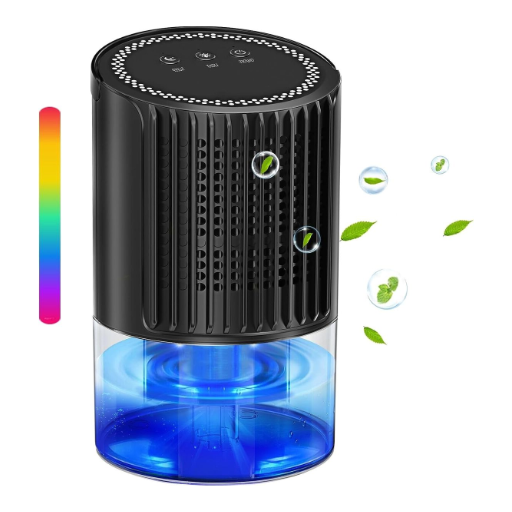A small bathroom often comes with a big problem: excess moisture. This moisture can lead to persistent odors, mold growth, and damage to your walls and fixtures if left unmanaged. That’s where a reliable dehumidifier comes in. But with so many options on the market, how do you find the best one for your space and requirements? This article will guide you through the critical factors to consider when selecting a small bathroom dehumidifier, providing expert insights to help you make an informed decision. Whether you’re battling high humidity levels or striving to create a healthier bathroom environment, we’ll help you identify the right solution for your needs.
Why Do You Need a Dehumidifier in Your Bathroom?
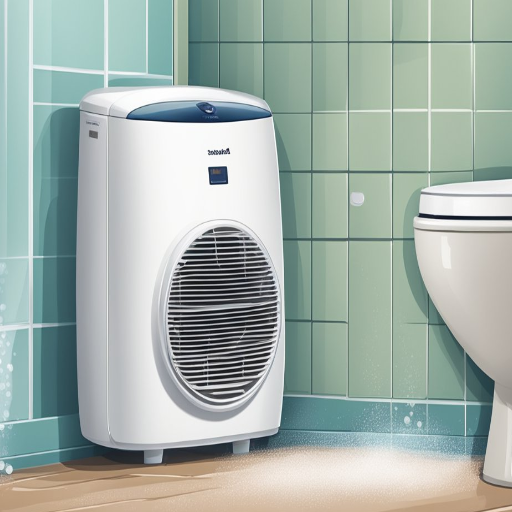
Understanding Humidity Levels in the Bathroom
The activities of showering, bathing, and even running hot water tend to create high humidity levels in the bathroom. If moisture is left in a contained area with no way to ventilate, it can become a very harmful mold, mildew, and bacteria breeding ground, which can be detrimental to health and can even damage structures.
Optimal indoor humidity is somewhere between 30%-50% relative humidity. However, bathrooms tend to have steam and moisture, which makes them cross that limit. The paint and grout surfaces within the bathroom tend to suffer in the long run due to deteriorating air quality and heightened chances of allergens, alongside lowered air quality.
The root cause of humidity issues is the moisture present in the sterilized batter. A dehumidifier extracts moisture and makes bathrooms healthier and safer spaces. With the appropriate dehumidifier, not only can the bathroom mitigate long-term damage, but the overall comfort of the space can be improved as well.
How a Dehumidifier Can Prevent Mold and Mildew
Because it actively lowers excess moisture in the air, a dehumidifier prevents the growth of mold and mildew. Mildew and mold germinate easily in mold in high-damp environments like bathrooms during and after activities. Dehumidifiers, therefore, curtail the ability for mold spores to grow and spread by maintaining humidity levels below 60%, the cited mold prevention threshold.
Dehumidifiers eliminate damp mold surfaces even on porous materials, effectively reducing the time moisture cools and settles. Steam and mold stubbornly persist in places with low ventilation, especially on grout, caulking, and corners of walls, where moisture stubbornly settles. A dehumidifier helps get rid of airborne moisture, enhancing resistance to fungal growth.
Operating a dehumidifier not only avoids construction damage from mold exposure but also enhances air quality. Mold spores, when inhaled, are potent allergens and irritants that can lead to respiratory problems and other health ailments. A dependable dehumidifier comes in handy to prevent the growth of mold and mildew, making it an important device in areas of high humidity.
Comparing a Dehumidifier with a Fan and Ventilation
Dehumidifiers, fans, and natural air flow all contribute to the improvement of air quality and the control of moisture levels; however, they differ in both function and effectiveness. A dehumidifier, for example, is the best device when it comes to the control of excess moisture–its primary purpose is to extract moisture from the air. Dehumidifiers are the best solution for areas prone to mold and mildew issues as they condense water vapor into liquid form, which directly reduces moisture levels in the air. This makes them the most effective appliances for damp environments.
On the other hand, fans are best suited for promoting air circulation; they do not alleviate the total humidity in the air. While aiding in a cooling effect, they may assist in the reduction of localized condensation, however, their effectiveness is reliant on the surrounding environment. Fans may worsen the situation in overly humid or poorly ventilated spaces as they may tend to spread moisture.
Natural ventilation via the opening of windows or passive vents introduces fresh air that can lower room humidity levels. Although this technique works for reducing moisture in certain environments, it is largely tempered by weather conditions. For example, in humid areas, outside air could make the problem worse. Unlike the use of dehumidifiers, natural ventilation is unable to achieve an optimal indoor humidity level and is not dependable for consistent results. Without a doubt, for precise, controllable, and reliable moisture removal, the dehumidifier is the unparalleled option.
What to Consider When Buying a Small Dehumidifier?

Choosing the Right Dehumidifier for Small to Medium Rooms
While choosing dehumidifiers for small and medium-sized rooms, the primary focus should be on features that impact performance and efficiency. Start by measuring the room’s square footage and check it against the unit’s capacity, generally expressed in pints per day. Smaller models suitable for 300 square foot rooms have capacities between 20 and 30 pints, while medium-sized ones that service 500 square foot areas have a capacity of 30 to 50 pints.
Assess the humidity level of the environment. Depending on how humid the area is, it may be necessary to use a more powerful dehumidifier designed for high-humidity zones, which is anything above 60% relative humidity, to maintain a comfortable indoor humidity level of 30%-50% relative humidity. Also, take into consideration noise levels, especially when the unit is meant for bedrooms or living spaces. Models with a decibel rating lower than 50 dB are ideal.
Dehumidifiers with built-in hygrometers, automatic shut-off features, and adjustable fan speeds certainly offer convenience and better performance. These features are very useful, especially in high-usage scenarios, because the device is equipped with larger water tanks or continuous drainage options, which reduce the need for frequent emptying. Lastly, check the maintenance requirements for the air filter, as this will affect overall air quality and the device’s longevity.
A dehumidifier’s specifications can be perfectly matched to a room’s environmental conditions. This not only enhances user comfort but also aids in lowering energy expenditure while achieving efficient humidity control.
Features to Look for in a Compact Dehumidifier
Consider focusing on features that improve performance, efficiency, and usability when selecting a compact dehumidifier. Some features to hone in on include:
- Dehumidification Range
Compact dehumidifiers differ in their daily moisture removal capacity (pints removed per day). Most models with a 20-30 pint per day capacity tend to work well for small to medium-sized rooms. To achieve optimal performance, choose an appropriate capacity according to the size and humidity level of the space.
- Tank Size and Drainage Options
Dehumidifiers that shrink in size or demand less space often come with more compact water tanks. For minimal frequent tank emptying, look for automatic drainage options such as a hose for endless drainage—ideal in high humidity regions.
- Noise Levels
As is the case with any electronic device, noise output measured in decibels (dB) can also be a critical consideration for devices intended for use in bedrooms. For a home office or any quiet space, compact models with noise under 50 dB are ideal.
- Automatic Features
User Convenience is of Utmost Importance, and Properly Automated Features Can Aid in That. Important options include adjustable humidistats that can maintain predefined humidity levels, balance power interruptions with its auto-restart capability, and the defrost setting that stops frost from forming on coil components.
- Filter Maintenance
An easy-to-maintain air filter is ultra-washable, reusable, and cost-effective, while servicing further enhances the improvement of overall air quality. Consistent keeping clean ensures straightforward processes while maintaining the consistent functioning of the dehumidifier.
- Compact Design and Portability
When it comes to convenience, saving space, enhanced compactness, lightness, stowability, handles, and caster wheels can be prioritized. Such saves hassle for devices which are stored and used across multiple rooms or within limited spatial boundaries.
- Advanced Sensors and Wi-Fi Connectivity
The subset of modern compact dehumidifiers offers smart sensors that track real-time humidity. Moreover, seamless command of functioning via smartphone apps can be enabled through Wi-Fi, making altering and monitoring device activity even more convenient.
Having consideration of such features, users are able to choose the most optimal compact dehumidifier to suit their specific needs, maximize control efficiency, and improve overall livability in a desired environment.
Understanding Water Tank Capacity and Maintenance
The tank’s volume directly impacts the operational cycles of most compact dehumidifiers since it relates to the quantity of moisture that the unit can remove from the air before needing to be emptied. Smaller, portable units tend to have smaller tanks ranging from 1 to 2 liters, making them useful for low-humidity locales like bedrooms or closets. On the other end of the spectrum are medium to large units, which have tanks capable of containing 5 liters or more, catering to larger or more humid regions like basements or laundry rooms. As it stands, choosing the right volume water tank will result in maximized dehumidification efficiency with minimized maintenance required by users.
Advanced dehumidifiers can come equipped with an array of additional features tailored towards simplifying maintenance and enhancing user experience. Many of these devices feature auto-shutoff functions that turn off the entire system once the tank’s volume reaches its upper limit to avoid spillage and potential water damage. In addition, several models are now offered with continuous drainage, which enables users to attach hoses to the unit for automatic water removal, further decreasing manual intervention. These advancements are especially useful for high-humidity areas where water withdrawal must be constant to ensure operations over extended periods without interruption.
It is crucial to properly maintain the water tank in order to ensure the unit operates efficiently and does not harbor bacteria or mold that can compromise the air quality. Regularly emptying the tank and washing it with warm, soapy water inhibits the growth of harmful microorganisms. Some manufacturers suggest regular cleaning with a gentle disinfectant solution to enhance hygienic conditions. Also, if the dehumidifier is set for continuous drainage, it is important to maintain the drainage system and check for any blockages. Following these maintenance routines will help users prolong the life of the dehumidifier while improving the quality of air in the home.
How to Effectively Dehumidify a Small Bathroom
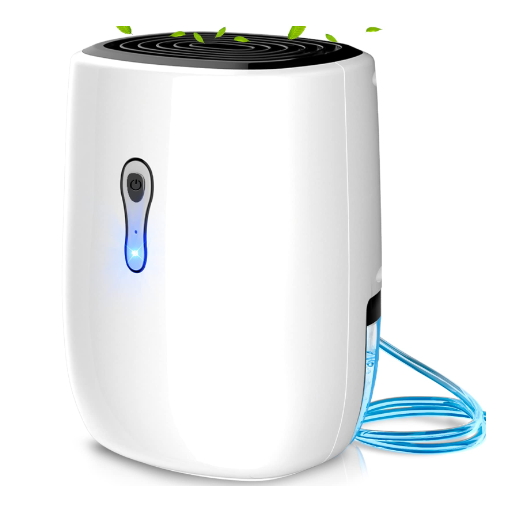
Tips for Optimal Placement of Your Bathroom Dehumidifier
Correct positioning of a dehumidifier in a small bathroom is key to ensuring maximum removal of moisture and optimum efficiency. Firstly, it is advisable to place the dehumidifier in a central and open area within the bathroom and not in corners or enclosed areas. Such placement enables free air circulation, which is critical for the unit to effectively pull moist air from all parts of the bathroom. Ensure that the device rests on level and firm ground to prevent unfaltering vibrations and noise while operating.
Moreover, as with any appliance, maintaining proper spacing around the dehumidifier is equally critical. Most manufacturers recommend a perimeter of 12-18 inches around the unit’s sides, especially around air intake and exhaust openings. This is done to avoid potential obstacles that can guarantee the flow of air needed by the system to operate efficiently. As a safety measure, do not position the dehumidifier close to direct water sources coming from shower heads or bathtubs to minimize the possibility of water surging into the unit and causing damage or serious electrical issues.
Finally, make certain that the power cord for the dehumidifier is neatly organized and that it has been connected to a GFCI outlet, which is common in moist locations such as bathrooms, and secured properly. Keep checking the unit’s position as well as the surrounding space for any signs of moisture, mold, or mildew, which could indicate excessive dampness and suggest the placement or functioning of the dehumidifier is less than optimal. Identifying these placement recommendations allows users to control the humidity level in the bathroom while increasing the operational efficiency and lifespan of the dehumidifier.
Combining Dehumidifiers with Other Moisture Control Methods
A thorough control of humidity in enclosed areas such as bathrooms is best accomplished when dehumidifiers are used in conjunction with other efficient techniques for moisture management. Ventilation is an example of an area that contributes positively to controlling humidity. Moisture-rich air is removed from bathrooms with exhaust fans, and this helps prevent walls and ceilings from accumulating condensation. Combining a high-capacity dehumidifier with an exhaust fan of appropriate size will not only improve the fan’s performance when it comes to moisture removal but also lighten the workload on the dehumidifier, which may help prolong the device’s operational life.
Another complementary method includes those that utilize moisture-absorbing materials and products like desiccants or specialized mold-resistant paints. Silica gel, clay desiccants, or calcium chloride pellets can be quite useful in capturing excess moisture in places with below-average air circulation, like corners and under sinks. In the same way, applying mold-resistant paints or sealants to bathroom walls and tiles will help the paints form a protective shell that stops mold or mildew from growing even in places with a lot of moisture.
Last, prevention of long-term exposed moisture damage and optimizing indoor air quality requires tackling the root of the humidity problem, which is regulating moisture levels over the long term. Responding to construction particulars, such as ensuring all windows are functioning correctly, sealed air-tight, removing condensation from harboring unresolved plumbing leaks, and insulating unshrouded pipes has demonstrated the capacity to better manage indoor air relative humidity. Using dehumidifiers within the context of this broad scope strategy ensures their effectiveness and achieves consistent results while mitigating health risks, dampness incurs enduring waterlogged structural components. This level of integration fosters an efficient and sustainable moisture control framework for bathrooms.
Maintaining Humidity Levels for Comfort and Health
For comfort and health, it is important to maintain humidity levels indoors within the range of 30% to 50%. Very high humidity can lead to mold, dust mites, and bacterial growth, which worsen respiratory diseases and aggravate allergies. Extremely low humidity, on the other hand, can result in an increased concentration of airborne pollutants, which leads to dry skin and respiratory irritation. Placing a hygrometer is one solution to measure and monitor indoor humidity consistently in real-time.
Smart home adaptability systems that control and manage humidity go a step further by incorporating accurate sensors with moisture control technologies that automatically adjust to changes in moisture levels. For example, high-efficiency particulate air (HEPA) filters can be used in exhaust fans placed in bathrooms and kitchens to eliminate localized high-moisture-content areas. Moreover, whole-house humidifiers and dehumidifiers can be integrated with HVAC systems to maintain balanced humidity throughout the building.
It is evident from the research that implementing energy-efficient practices, including the improvement of insulation and reduction in air leakage, minimizes changes in humidity by diminishing the inflow of outside air. This improves comfort and reduces energy expenditure on HVAC systems. Controlled humidity, with the aid of advanced systems and green building materials, guarantees an improved quality of the indoor environment and a healthier building over time. This approach follows the most suitable requirements of personal health and energy-efficient living.
What Are the Best Dehumidifiers for Small Bathrooms?
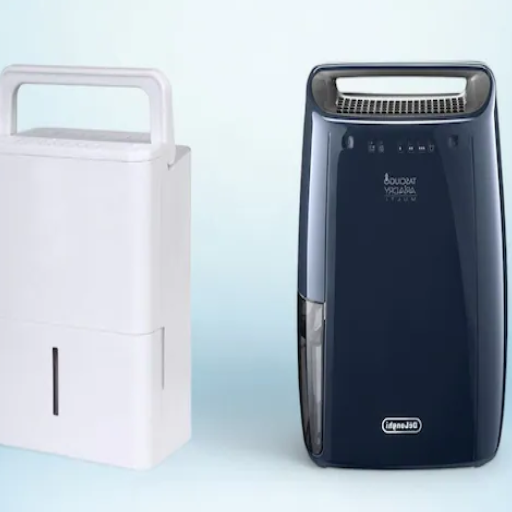
Factors that Make a Good Dehumidifier for Bathrooms
I like to think of a dehumidifier’s function concerning humidity control from the perspective of a high-capacity unit ideal for the bathroom. This is because bathrooms cultivate excess moisture from showers and baths that can foster mold and mildew growth if not kept under control. A decent dehumidifier for a given bathroom needs to have the capability to remove moisture with high efficiency, and I usually base my judgment on the unit’s pint capacity, which indicates the amount of moisture it can extract daily. A compact model with lower capacity may suffice for small bathrooms, but larger or poorly ventilated areas would require a more robust unit.
A user-friendly design coupled with simple maintenance tasks, such as an automatic shut-off function and clear tank water indicators, greatly enhances ease of use. Any filter that is easy to clean will extremely help reduce the burden of operating a dehumidifier. Someone like me would consider whether the device has a continuous drainage option, which significantly minimizes the need to empty the tank manually in places where humidity buildup is consistent.
In conclusion, I look at other factors like energy consumption, noise level, and other added features. With an Energy Star certification, electricity usage is lower, which is advantageous over time both financially and environmentally. For bathrooms, I like quiet models because the noise level in small spaces can be much more troublesome. Air purifiers can be incorporated into a humidifier as an added feature, as well as customizable humidity settings, which not only provide comfort but also improve the overall air quality while still keeping the space free of moisture.
Cost-Effective Options for Dehumidifying Small Spaces
Cost-effective options for small rooms should be selected based on how well they operate for their price. Electric mini dehumidifiers are ideal for use in small, compact spaces like bathrooms, closets, or storerooms. Thermaelectric or Peltier technology is commonly used in these units, and is advantageous because it uses low energy while being less noisy. Units with a daily moisture removal rate of two to three hundred milliliters are often good enough for areas below two hundred feet.
Desiccant dehumidifiers, which use silica gel for moisture absorption materials, are also an effective choice because of their energy efficiency. They do not use electricity, and can be reused through drying or recharging. Environmentally friendly users might want to use solar-powered dehumidifiers, as these would be a great investment in the long run since they rely on renewable energy.
Besides these, programmable dehumidifiers with smart humidity sensors are great because one can control their use only when they are needed. Opting for durable easy to easy-to-clean filters will enhance the long-term cost effectiveness of small space dehumidifiers.
How to Maintain Your Bathroom Dehumidifier?
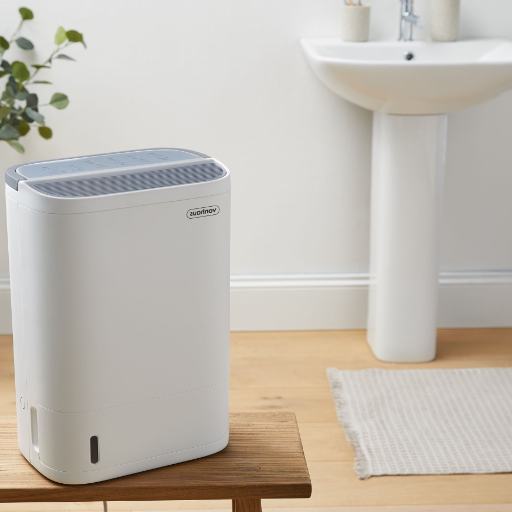
Cleaning and Caring for Your Dehumidifier
To maintain optimal functioning and prolong the life of your bathroom dehumidifier, routine maintenance is crucial. Start by ensuring the device is disconnected from the electrical outlet before any cleaning steps for the sake of safety. The most important step involves the air filter; it should be cleaned or replaced according to the manufacturer’s directions, typically every one to three months. Air flow and, thus, efficiency can be severely reduced as a result of a dirtied or clogged filter.
Use a soft, damp cloth to clean the external housing, removing any accumulated dust and grime. Do not use harsh cleaning products because they may ruin surface features or if used improperly, internal parts. In order to prevent mold or bacterial growth, the water collection tank, if present, should be sanitized regularly. In this case, warm water mixed with some mild detergent is ideal to clean the tank; however, it also needs to be thoroughly dried before reinstallation.
Check all air intake and exhaust vents for potential blockages, and vacuum or brush away any pieces of dirt. If you have a dehumidifier with a constant drainage feature, remember to check the hose for any leaks or blockages and clean it periodically. Following these maintenance steps, while improving dehumidifier functionality, also optimally elevate the device’s useful lifespan, thereby enhancing bathroom hygiene and humidity control.
When to Replace Your Dehumidifier
Re-evaluating your dehumidifier within the context of its replacement is an absolute necessity when it is expected to no longer perform efficiently, or when its repair cost begins exceeding the value accrued from further use. Dehumidifiers, on average, last roughly between five to ten years, but this may change based on how frequently it is used, how well they are maintained, and the surrounding environment. Signs showing that replacement may be necessary include chronic issues such as the device no longer extracting moisture from the air, the unexplained surge in energy consumption, or notable rattling and grinding that suggest some mechanical failure.
Modern-day advancements should also be taken into account. Dehumidifiers available in the market today score better when it comes to energy efficiency, have smart/hyper controls, and possess better filters, which can result in better performance and lower operational expenses. If your current dehumidifier provides you with no modernized benefits, upgrading to a newer model would be more efficient in terms of cost, whilst also ensuring a reliable solution.
Combining the age of your dehumidifier with potential maintenance costs allows for better decision-making. Furthermore, comparing the estimate for repairs with the purchasing price of a new dehumidifier aids in uncovering the most practical, cost-effective, and time-effective route.
References
-
Further Investigation of Energy and Performance Impacts of Whole-House Dehumidifier Duct Configurations – Research on the energy and performance impacts of dehumidifiers.
-
Optimizing energy efficiency and improved dehumidification performance of variable capacity air conditioning systems – A study on dehumidification performance and energy efficiency.
-
Energy-Efficient Management of Mechanical Ventilation and Relative Humidity in Hot-Humid Climates – Research on managing humidity and ventilation efficiently.
Frequently Asked Questions (FAQ)
Q: Why is it important to use a dehumidifier in a small bathroom?
A: Using a dehumidifier in a small bathroom is crucial to avoid mold and mildew, which thrive in high-humidity environments. It helps keep the air in the room dry, reducing the risk of musty odors and promoting a healthier home environment.
Q: What should I consider when choosing a portable dehumidifier for my bathroom?
A: When selecting a portable dehumidifier for your bathroom, consider its size, capacity, and features such as a humidistat. Ensure it’s suitable for the room’s humidity level and has an auto shut-off feature when the tank is full.
Q: How does a dehumidifier for your bathroom help with asthma?
A: A dehumidifier can help reduce humidity in your bathroom, lowering the risk of mold and dust mites, which are common asthma triggers. This can help improve air quality and reduce asthma symptoms.
Q: Can I just open the window or use a fan in the bathroom instead of a dehumidifier?
A: While opening a window or using an exhaust fan can help reduce humidity, a dehumidifier is more effective in maintaining consistent humidity levels, especially when windows are closed during cold weather.
Q: What is the role of a humidistat in a dehumidifier?
A: A humidistat in a dehumidifier measures and controls the humidity in the room, allowing the dehumidifier to operate efficiently and maintain desired humidity levels to keep the air comfortable and prevent mold growth.
Q: How often should I empty the condensate tank in the dehumidifier?
A: The frequency of emptying the condensate tank depends on the humidity level and the size of the tank. When the tank is full, most dehumidifiers have an auto shut-off feature to prevent overflow.
Q: Is an evaporative dehumidifier suitable for a small bathroom?
A: An evaporative dehumidifier can be suitable for a small bathroom as it efficiently reduces humidity. However, ensure it fits well in the space and meets the room’s dehumidification needs.
Q: How does using an exhaust fan or vent fan complement a dehumidifier?
A: Using an exhaust fan or vent fan alongside a dehumidifier can enhance moisture removal after a hot shower, ensuring the bathroom remains well-ventilated and reducing the workload on the dehumidifier.

